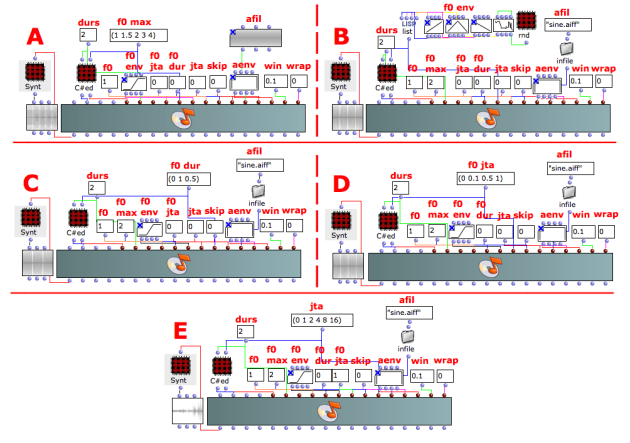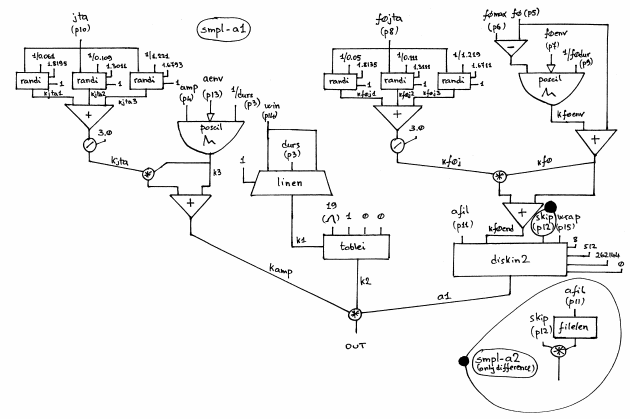Reading from a Sound file with SMPL-A1
Tutorial SMPL-A1
Name | Description | Default value |
|---|---|---|
amp | Maximum Amplitude. Linear from >0.0 to 1000 or in dB from 0 to -∞ (see Tutorial Getting Started 02 - Amplitude and Internal Editor for more details) | 0.0 |
f0 | Minimum value of the pitch transposition of input sound by this factor (e.g. 0.5 means one octave lower, 2 is one octave higher, and 1 is the original pitch). Fractional and negative values are allowed (the latter results in playing the file backwards) | 1.0 |
f0max | Maximum value of the pitch transposition of input sound by this factor . | 2.0 |
f0env | Envelope of the pitch transposition between f0 and f0max | Instance: GEN07 |
f0jta | Jitter's amplitude of the fundamental frequency [% of f0] | 0.1 |
f0dur | Duration of the envelope of the pitch transposition [sec, if 0, take global duration] | 0 |
jta | Amplitude of the jitter/random source [%] | 0.5 |
afil | Audio file [name, with possible path, sound, string, pathname or GEN01] | File: santuri_96 |
skip | (Minimum) starting point when reading an audio file [sec] | 0.0 |
aenv | Amplitude Envelope [GEN] | Instance: GEN07 |
win | Attack and decay time in [sec] | 0.01 |
wrap | Wrap flag: 0=locations beyond EOF produce silence, <>0=wrap from beg of file | 1 |
The Smpl-A1 Class is a Sampler with the following controls:
- The main ampllitude,
- The transposition range,
- The transposition envelope by means of a GEN routine,
- The frequency of the transposition envelope,
- The range and amplitude of the jitter of the frequency,
- The starting point of the audio file,
- The amplitude envelope by means of a GEN routine,
- The attack and decay time of the total duration of the amplitude envelope,
- The wrapping mode (enable or disable)
The example A displays many transposition's ranges.
The example B collects four different transposition's envelopes.
The example C considers closely the frequency of the transposition's envelope. The default value is 0 and take the global duration, the other values express the cycle per second of the envelope.
The example D deals with the frequency's jitter, which is equal to the pitch transposition multiplied by the given data (f0*f0jta).
The example E shows the effects of the amplitude of the jitter.
The meaning of the other slots is the same as the SMPL-1 Class. So see the Tutorial SMPL-1 for more details.
For the red patches Synt, C#ed and rnd see Appendix-A.
Inside the Class
instr 1
idur = p3
idurosc = 1/idur
iamp = (p4 > 0.0 ? (p4*0.001) : (10 ^ (p4/20.0)))
; amplitude relative to the sound file (to avoid multiplying twice)
if0min = p5 ; min transposition factor
if0max = p6
if0d = if0max-if0min
if0env = p7
if0jt = p8
if0dur = (p9 > 0 ? p9 : idur)
ijta = p10
ifile = p11
iskip = (p12 < 0.0 ? (p12*if0min) : p12)
; to make the value not depend on the xposition factor if it's negative
iskip = p12
iaenv = p13 ; global amplitude envelope
iwin = (p14 > idur/2 ? idur/2 : p14) ; local envelope
iwout = iwin
iwrap = p15
print iskip
ixmode = 1 ; index between 0 and 1
ixoff = 0 ; index offset
ixrap = 0 ; no wraparound in table reading
iformat = 8 ; 24-bit int, ignored if the sound file has a header
iwsize = 512 ; the bigger, the better the quality of the transposition
ibufsize = 262144 ; maximum = 1048576, higher makes less disk access
iskipinit = 0 ; do not skip initialization
isize = 1 ; 31-bit random number for randi
iaudiofun = 1
isigfun = 19 ; sigmoid function
;f0
; jitter for f0
; seed>1.0=> seed from the system time
kf0j1 randi if0jt, 1/0.05, 1.8135, isize
kf0j2 randi if0jt, 1/0.111, 1.3111, isize
kf0j3 randi if0jt, 1/1.219, 1.6711, isize
kf0j = (kf0j1+kf0j2+kf0j3)/3.0
;f0 envelope
kf0env poscil if0d, 1/if0dur, if0env
kf0 = kf0env+if0min
kf0end = kf0+(kf0*kf0j)
; local envelope (for the grain)
k1 linen 1,iwin,idur,iwout
k2 tablei k1,isigfun,ixmode,ixoff,ixrap
; jitter for amp
; seed>1.0=> seed from the system time
kjta1 randi ijta, 1/0.061, 1.8195, isize
kjta2 randi ijta, 1/0.109, 1.3011, isize
kjta3 randi ijta, 1/1.221, 1.6793, isize
kjta = (kjta1+kjta2+kjta3)/3.0
; global envelope
k3 poscil iamp, idurosc, iaenv
kamp = k3+(k3*kjta)
; file reading
a1 diskin2 ifile, kf0end, iskip, iwrap, iformat, iwsize, ibufsize, iskipinit
asound = a1*k2*kamp
outc asound
endin
- OMChroma User Manual
- System Configuration and Installation
- Getting started
- Managing GEN function and sound files
- Predefined Classes
- User-fun
- Creating a new Class
- Multichannel processing
- Appendix A - Common Red Patches


